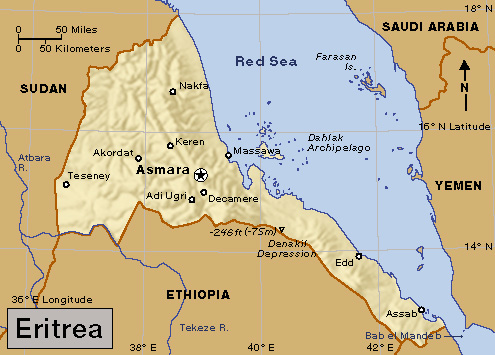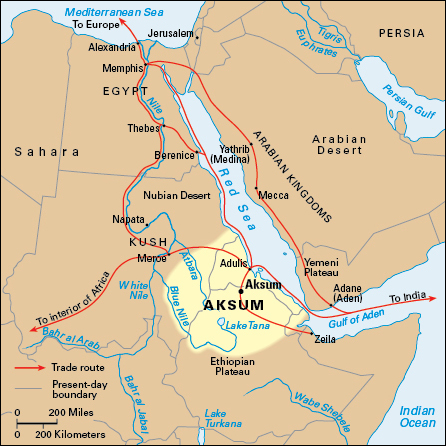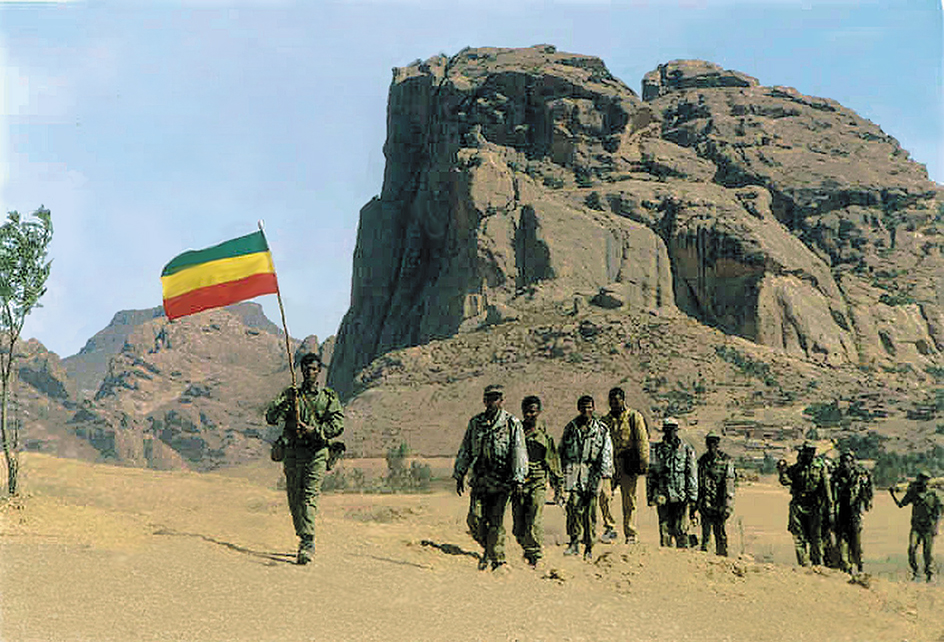Eritrea << `ehr` ih TREE uh >> is a small country on the northeast coast of Africa. It stretches along the Red Sea, between Sudan and Djibouti. Ethiopia lies to the south. Most of Eritrea’s people are farmers or herders. The country has little industry. Asmara is Eritrea’s capital and largest city. The country’s official name is the State of Eritrea.

Eritrea was once a part of the Aksum Kingdom. The kingdom reached its height as a trading and cultural center between the A.D. 300’s and 600’s. Italy gained control of Eritrea in the late 1800’s. The United Kingdom took over the area in 1941, during World War II. In 1952, Eritrea became part of Ethiopia.
In 1961, civil war broke out between Eritrean rebels, who wanted independence for their land, and Ethiopian government troops. The war finally ended in 1991, with a victory by Eritrean and other rebels. Eritrea formally achieved independence in 1993.
Government.
Eritrea has had a transitional (temporary) government since the nation gained independence. The People’s Front for Democracy and Justice (PFDJ), Eritrea’s only legal political party, dominates the government. Formerly called the Eritrean People’s Liberation Front (EPLF), the party led the fight for Eritrea’s independence. In 1997, Eritrea approved a new constitution providing for an elected legislature. But the constitution has not yet been implemented. A president heads the transitional government. The president is chosen by a transitional legislature called the National Assembly.

People.
Most Eritreans are descendants of people from the Arabian Peninsula and from the Nile River region of Sudan who came to the area starting about 2000 B.C. Tigrinya is Eritrea’s chief language. Tigre is the second most common language. Arabic is spoken on the coast. Groups of herders speak Afar or other languages.
About 80 percent of the people of Eritrea are farmers or herders. Farming families live in walled or fenced settlements. The homes have flat thatched roofs or peaked roofs made of corrugated iron. Most farm households consist of an extended family that may include up to several dozen relatives. Farmers meet for occasional market days, festivals, or at regional village towns. Herders move from place to place with their livestock.
About half the Eritreans are Christians. Most of the others, including many herders, are Muslims. Coptic Christianity, a form of Christianity that originated in Egypt, was brought to the country in the A.D. 300’s. Islam came to Eritrea in the 600’s.
Eritrea’s educational system was shaped under Italian rule and expanded under British rule. The long civil war severely disrupted the educational system. As a result, a majority of Eritrea’s children have not received much formal education. Illiteracy remains a serious problem in the country.
Land and climate.
Eritrea stretches along the Red Sea from Cape Kasar to the Strait of Bab el Mandeb—a distance of about 620 miles (1,000 kilometers). A coastal plain along the Red Sea ranges from 10 to 40 miles (16 to 64 kilometers) in width. The plain rises to highlands in the central part of Eritrea. Mount Soira, in the highlands, is the country’s highest peak. It rises 9,885 feet (3,013 meters) above sea level. The highlands drop to lowlands in the west. Denakil Desert covers the southeastern part of the country.
The country’s main rivers flow westward, cutting valleys through the central highlands and western lowlands. The main rivers of Eritrea include the Baraka and the Gash. The Gash is called the Marab for part of its length.
Temperatures average 86 °F (30 °C) along the coast and 60 °F (16 °C) in the highlands. The coast receives about 6 to 10 inches (15 to 25 centimeters) of rain a year, and the highlands receive up to 24 inches (61 centimeters). In most parts of the country, the heaviest rains occur in June and July.
Economy.
Eritrea faces a number of economic problems. It is a poor country, and many of its people live in poverty. Eritrea’s economy suffered severely during the Ethiopian civil war from 1961 to 1991. The economy began to improve somewhat after the war. However, it was devastated again by a border conflict between Eritrea and Ethiopia from 1998 to 2000.
Eritrea’s people largely depend on subsistence agriculture. However, the country’s agriculture has suffered from recurring periods of drought. Crops are primarily grown in the central highlands. The country’s main crops include barley, millet, sorghum, and wheat. Farmers also grow teff, a grain that is common only in Eritrea and Ethiopia. Livestock raising is concentrated along the coast and in the western lowlands. Herders raise beef and dairy cattle, goats, and sheep.
Manufacturing contributes a small amount to Eritrea’s economy. The country’s chief manufactured or processed products include construction materials, leather goods, and processed foods. Eritrea’s deposits of gold, petroleum, and other mined products are underdeveloped.
Eritrea is strategically located for trade. The country imports more than it exports. Eritrea’s main trading partners include China, Italy, and Saudi Arabia. Massawa and Assab rank as its chief ports.
History.
About 2000 B.C., people from the interior of Africa settled in what is now Eritrea. About 1000 B.C., people began arriving from the Arabian Peninsula.
The Aksum Kingdom became the first important state in the area. The kingdom gained importance about A.D. 50 and reached its greatest power between the 300’s and 600’s. During the 600’s, Muslims gained control of the area.

The coastal region of Eritrea came under the rule of the Ottoman Empire in the 1500’s. About the same time, kingdoms from what are now Ethiopia and Sudan fought over the rest of Eritrea. In the 1800’s, Egypt, France, and Italy attempted to gain control of Eritrea.
In 1882, Italy occupied the port of Assab. In 1885, it occupied the port of Massawa and other regions along the coast. By 1889, Italy had conquered all of Eritrea. Italy used Massawa as a base for an invasion of Ethiopia. Ethiopian Emperor Menelik II defeated the Italian forces in 1896. But Italy conquered Ethiopia in 1935.
During the period that Eritrea was under Italy’s control, the Italian government invested in agricultural plantations and established a number of industries. About 60,000 Italians settled in Eritrea.
British forces drove the Italians out of Africa in 1941, during World War II. A British military administration then began governing Eritrea. In 1950, the United Nations General Assembly adopted a resolution that Eritrea become part of Ethiopia, but govern itself. The resolution was put into effect in 1952.
The Ethiopian government, led by Emperor Haile Selassie, sought to undermine Eritrea’s self-government by banning political parties and trade unions in Eritrea. But the Eritreans started a political movement called the Eritrean Liberation Front (ELF). In 1961, civil war broke out between the ELF and the Ethiopian government. In 1962, Ethiopia declared Eritrea to be a province of Ethiopia.
In 1970, the Eritrean People’s Liberation Front (EPLF) was formed. The EPLF gradually replaced the ELF as Eritrea’s main political organization. In 1974, Ethiopian military leaders removed Haile Selassie from power. They set up a government called the Dergue. The EPLF tried to negotiate with the Dergue for Eritrean independence. But the talks failed, and the civil war continued.
In 1987 and 1988, victories against Ethiopian government forces by EPLF forces and forces from the Tigray region, south of Eritrea, led to a collapse of central government rule throughout much of Ethiopia.
In 1991, Eritrean rebels joined with a group of rebels led by Tigrayans to overthrow Ethiopia’s government. The rebel group led by Tigrayans established a new government for all of Ethiopia except Eritrea. The Eritreans formed their own government. They formally declared independence from Ethiopia on May 24, 1993, after a referendum (popular vote) in favor of independence. EPLF leader Isaias Afwerki became president of the new country. In 1994, the EPLF became a political party called the People’s Front for Democracy and Justice. Eritrea adopted a new constitution in 1997, but it has never been implemented.
When Eritrea achieved independence, a section of the border with Ethiopia was not clearly defined. Eritrea and Ethiopia fought a war over this disputed area from 1998 to 2000, when they signed a peace treaty. The treaty established a commission to identify the border between the two countries. The commission issued a border ruling in 2002. However, Ethiopia objected to the ruling, and the border remained in dispute. In December 2005, both Eritrea and Ethiopia began sending more troops along the border. That same month, an international court based in The Hague, Netherlands, blamed Eritrea for starting the border war. In 2009, the court ruled that Eritrea owed Ethiopia $10 million for war damages. Both countries accepted the ruling. In 2018, Ethiopia agreed to accept the border commission’s 2002 decision and to return disputed areas to Eritrea. The countries signed a peace agreement in July 2018. Later that year, several crossing points on the long-disputed border were temporarily opened. 
Recurrent droughts over the horn of Africa affected Eritrea throughout the early 2000’s. As a result, more than 2 million people faced food insecurity, malnutrition, and starvation.
In 2020, fighting broke out in Ethiopia’s northern state of Tigray. Eritrea sent troops to support the Ethiopian government. By 2022, thousands of Tigrayans had died and more than a million others had been displaced by the fighting. Eritrean soldiers have been charged with committing atrocities against civilians in the conflict.
